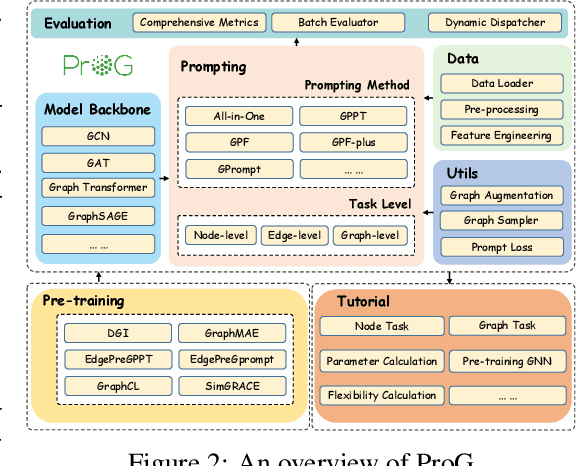Yiqing Lin
UniGAD: Unifying Multi-level Graph Anomaly Detection
Nov 10, 2024Abstract:Graph Anomaly Detection (GAD) aims to identify uncommon, deviated, or suspicious objects within graph-structured data. Existing methods generally focus on a single graph object type (node, edge, graph, etc.) and often overlook the inherent connections among different object types of graph anomalies. For instance, a money laundering transaction might involve an abnormal account and the broader community it interacts with. To address this, we present UniGAD, the first unified framework for detecting anomalies at node, edge, and graph levels jointly. Specifically, we develop the Maximum Rayleigh Quotient Subgraph Sampler (MRQSampler) that unifies multi-level formats by transferring objects at each level into graph-level tasks on subgraphs. We theoretically prove that MRQSampler maximizes the accumulated spectral energy of subgraphs (i.e., the Rayleigh quotient) to preserve the most significant anomaly information. To further unify multi-level training, we introduce a novel GraphStitch Network to integrate information across different levels, adjust the amount of sharing required at each level, and harmonize conflicting training goals. Comprehensive experiments show that UniGAD outperforms both existing GAD methods specialized for a single task and graph prompt-based approaches for multiple tasks, while also providing robust zero-shot task transferability. All codes can be found at https://github.com/lllyyq1121/UniGAD.
ProG: A Graph Prompt Learning Benchmark
Jun 08, 2024



Abstract:Artificial general intelligence on graphs has shown significant advancements across various applications, yet the traditional 'Pre-train & Fine-tune' paradigm faces inefficiencies and negative transfer issues, particularly in complex and few-shot settings. Graph prompt learning emerges as a promising alternative, leveraging lightweight prompts to manipulate data and fill the task gap by reformulating downstream tasks to the pretext. However, several critical challenges still remain: how to unify diverse graph prompt models, how to evaluate the quality of graph prompts, and to improve their usability for practical comparisons and selection. In response to these challenges, we introduce the first comprehensive benchmark for graph prompt learning. Our benchmark integrates SIX pre-training methods and FIVE state-of-the-art graph prompt techniques, evaluated across FIFTEEN diverse datasets to assess performance, flexibility, and efficiency. We also present 'ProG', an easy-to-use open-source library that streamlines the execution of various graph prompt models, facilitating objective evaluations. Additionally, we propose a unified framework that categorizes existing graph prompt methods into two main approaches: prompts as graphs and prompts as tokens. This framework enhances the applicability and comparison of graph prompt techniques. The code is available at: https://github.com/sheldonresearch/ProG.
Opinion Dynamics in Two-Step Process: Message Sources, Opinion Leaders and Normal Agents
Sep 11, 2023



Abstract:According to mass media theory, the dissemination of messages and the evolution of opinions in social networks follow a two-step process. First, opinion leaders receive the message from the message sources, and then they transmit their opinions to normal agents. However, most opinion models only consider the evolution of opinions within a single network, which fails to capture the two-step process accurately. To address this limitation, we propose a unified framework called the Two-Step Model, which analyzes the communication process among message sources, opinion leaders, and normal agents. In this study, we examine the steady-state opinions and stability of the Two-Step Model. Our findings reveal that several factors, such as message distribution, initial opinion, level of stubbornness, and preference coefficient, influence the sample mean and variance of steady-state opinions. Notably, normal agents' opinions tend to be influenced by opinion leaders in the two-step process. We also conduct numerical and social experiments to validate the accuracy of the Two-Step Model, which outperforms other models on average. Our results provide valuable insights into the factors that shape social opinions and can guide the development of effective strategies for opinion guidance in social networks.
 Add to Chrome
Add to Chrome Add to Firefox
Add to Firefox Add to Edge
Add to Edge